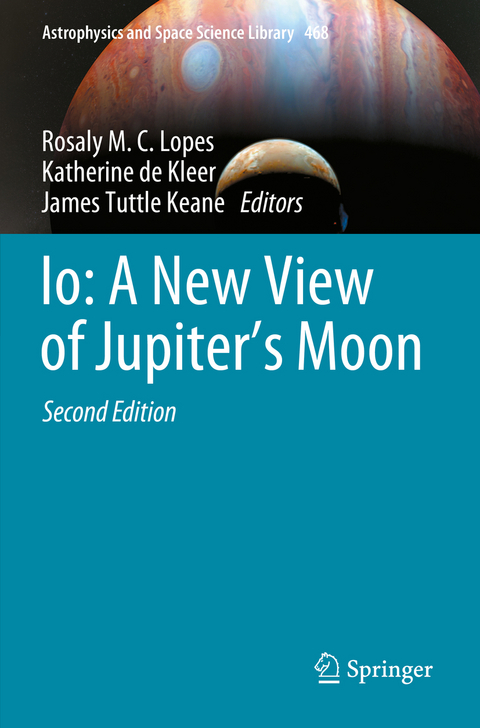
Io: A New View of Jupiter’s Moon
Springer International Publishing (Verlag)
978-3-031-25672-1 (ISBN)
Written by expert researchers, this book covers all the major aspects of research in Jupiter's moon Io, from the interior to its space environment. Io is one of the Solar System's most exotic satellites. The book discusses Io's interior, geology, atmosphere, and, in particular, its active volcanism, which was discovered from observations by the Voyager 1 spacecraft in 1979, confirming a possibility suggested from theoretical studies based on Io's orbit. Our knowledge of Io's volcanism, composition, and space environment was significantly increased as a result of observations by other spacecrafts, including Galileo.
More than a decade after the 1st edition, "Io After Galileo", this 2nd edition of the book now includes results obtained by the New Horizons mission and, more recently, Juno. It also presents observational results from ground-based telescopes using adaptive optics having provided resolutions that rival those of spacecraft.
The book provides a review of the current status of Io research and gives an outlook to planned future observations. It thus serves as reference for researchers in the field and an introduction for PhD students and newcomers planning to study this exotic Solar System moon.
Dr. Rosaly M. C. Lopes was the lead editor of an earlier version of this book, Io After Galileo. Dr. Lopes is a senior research scientist and Directorate Scientist for Planetary Science at the Jet Propulsion Laboratory, and former editor-in-chief of the planetary science journal Icarus. She obtained a BSc in astronomy and PhD in planetary science from University College London, UK. Her research expertise is in planetary geology and volcanology and she has studied Mars, Io, and Titan. She was a member of the Galileo mission to Jupiter and the Cassini mission to Saturn. She is a Fellow of the American Association for the Advancement of Science, the Geological Society of America, and the American Geophysical Union. She has received several awards including the Carl Sagan Medal from the American Astronomical Society, the Ambassador Award from the American Geophysical Union, and two NASA Exceptional Public Service Medals.
Dr. Katherine de Kleer is an Assistant Professor of Planetary Science and Astronomy at Caltech. She obtained her BSc in mathematics and physics from MIT and her MA and PhD in astrophysics from UC Berkeley. Her research focuses on the surface environments, atmospheres, and thermochemical histories of the Solar System's planets and satellites, which she investigates via observational signatures at optical, infrared, and radio wavelengths. She has particular expertise in Io's volcanic activity and atmosphere, and uses cutting-edge Earth-based telescopes to study these systems with the aim of unravelling the various internal and external processes that together drive Io's observable characteristics.
Dr. James Tuttle Keane is a planetary scientist at the Jet Propulsion Laboratory in Pasadena, California. He obtained a BSc in Geology and a BSc in Astronomy from the University of Maryland, College Park, and a PhD in Planetary Science from the University of Arizona Lunar and Planetary Laboratory. Dr. Keane is an expert on the interactions between orbital dynamics, rotational dynamics, and geologic processes on rocky and icy worlds across the Solar System-including Earth's moon, Io, Pluto, and beyond. He uses a combination of theoretical methods, coupled with the analysis of spacecraft-derived datasets to investigate the dynamics, structure, origin, and evolution of solar system bodies. He has extensive experience with NASA planetary science missions, including the GRAIL mission that mapped the Moon's gravity field, the New Horizons mission to Pluto and the Kuiper belt, the Juno extended mission that is characterizing Jupiter and its moons, and the proposed Io Volcano Observer. In addition to science, Dr. Keane is an accomplished science illustrator and communicator, specializing in pen and pencil illustrations of planetary science concepts, new results, and exciting missions.
Chapter 1: Introduction.- Chapter 2: Understanding Io: Four centuries of study and surprise.- Chapter 3: Setting the Stage: Formation and Earliest Evolution of Io.- Chapter 4: Tidal Heating and the Interior Structure of Io.- Chapter 5: Geology of Io.- Chapter 6: Io's Thermal Emission and Heat Flow.- Chapter 7: The 1 Composition of Io.- Chapter 8: The Plumes and Atmosphere of Io.- Chapter 9: Space Environment of Io.- Chapter 10: Io as an Analog for Tidally Heated Exoplanets.- Chapter 11: Outstanding Questions and Future Observations of Io.- Index.
"This latest review of Io is full of fascinating data, richly illustrated, crammed with references, and is much to be welcomed." (Richard McKim, The Observator, Vol. 144 (1300), June, 2024)
| Erscheinungsdatum | 11.06.2024 |
|---|---|
| Reihe/Serie | Astrophysics and Space Science Library |
| Zusatzinfo | XII, 375 p. 118 illus., 88 illus. in color. |
| Verlagsort | Cham |
| Sprache | englisch |
| Maße | 155 x 235 mm |
| Themenwelt | Naturwissenschaften ► Physik / Astronomie ► Astronomie / Astrophysik |
| Schlagworte | Galilean satellites • Galileo space mission • Io atmoshere • Io geology • Io Jupiter moon • Io volcanism • Juno space mission • Jupiter moons • Jupiter space missions • New Horizons space mission • planetary volcanism • solar system moons |
| ISBN-10 | 3-031-25672-7 / 3031256727 |
| ISBN-13 | 978-3-031-25672-1 / 9783031256721 |
| Zustand | Neuware |
| Haben Sie eine Frage zum Produkt? |
aus dem Bereich


